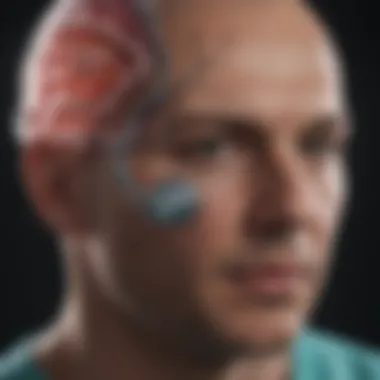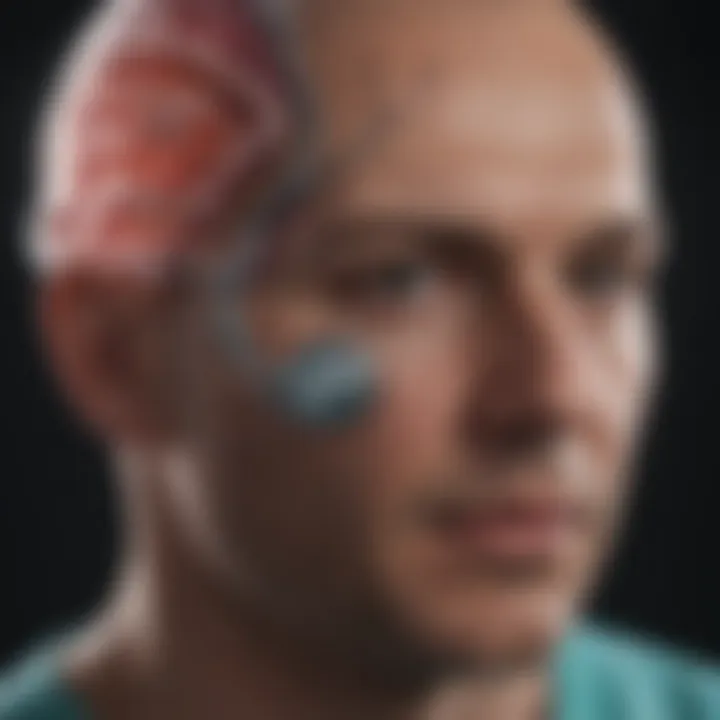Innovative Strategies for Brain Tumor Management


Intro
The management of brain tumors requires a thorough understanding of various approaches and methodologies that are fundamental in providing effective solutions. This field has seen notable advances ranging from surgical techniques to pharmacological interventions. The complexity inherent in brain tumors necessitates a multidisciplinary perspective, integrating knowledge across several domains. This article aims to illuminate the various strategies currently available and those on the horizon for tackling brain tumors.
This discourse not only highlights the key points concerning different treatment modalities but also emphasizes the relevance of personalized medicine in shaping future patient outcomes. As we delve into this landscape, it is essential to remain abreast of the latest research trends and innovations that promise to redefine therapeutic strategies.
Methodology
Overview of research methods used
The research presented is founded on a synthesis of various studies that include clinical trials, cohort studies, and case reports. It involves a review of published literature to distill findings relevant to different treatment options available for brain tumors. In addition, comparative analyses of outcomes allow for a comprehensive understanding of the efficacy of these therapies.
Data collection techniques
Data was gathered through several methods:
- Systematic Literary Review: Analyzing journals and databases such as PubMed and Google Scholar.
- Clinical Registries: Examination of patient data collected from hospitals and tumor registries.
- Expert Interviews: Insights gleaned from interviews with neurologists, oncologists, and radiologists who specialize in brain tumors.
These methods provide rigor and depth to the analysis, supporting the conclusions drawn about treatment efficacy and future trends.
Future Directions
Upcoming trends in research
The field of brain tumor research is constantly evolving, driven by technological advancements and a deeper understanding of tumor biology. Emerging trends include the use of:
- AI and Machine Learning: Utilizing algorithms to better predict tumor progression and treatment response.
- Targeted Therapies: Focusing on specific genetic mutations found in tumors to develop customized treatment plans.
- Immunotherapy: Harnessing the body's immune system to identify and destroy cancer cells more effectively.
Areas requiring further investigation
Despite significant progress, several areas still require concerted research efforts:
- Long-term Efficacy Studies: Understanding how treatments affect patient survival over extended periods.
- Quality of Life Assessments: Evaluating the impact of treatment options on the overall well-being of patients.
- Access and Equity in Treatment: Investigating disparities in treatment availability and outcomes across different populations.
"The future of brain tumor management lies in personalized approaches that are informed by ongoing research and technological innovations."
In summary, the solutions for brain tumors extend far beyond traditional methods. With ongoing research and adaptation of new therapies, there is a great opportunity to enhance patient outcomes significantly.
Prelude to Brain Tumors
Understanding brain tumors is fundamental in the field of neurology and oncology. Brain tumors can occur in various forms and affect individuals differently. This article delves into the complexities surrounding brain tumors, including their types, diagnostics, and treatment options. Addressing the topic of brain tumors is crucial as it highlights the need for timely diagnosis and effective management strategies.
A comprehensive approach is necessary to tackle brain tumors, considering their unpredictable nature and the potential impact on patients' quality of life. Advances in medical science have led to improved outcomes, but challenges remain. By laying out the intricacies of brain tumors, this article aims to inform readers on the latest advancements and perspectives in addressing these challenging conditions.
Understanding Brain Tumors
Brain tumors are classified as growths that occur in the brain tissue or its surrounding area. They can arise from various cell types. Primary brain tumors originate within the brain, while secondary brain tumors develop from cancer spreading from another part of the body. Understanding the differences between these types is essential for accurate diagnosis and treatment.
Identifying the type of tumor is critical for the management plan. Timing is vital; early detection can significantly improve treatment outcomes. Awareness of symptoms such as headaches, seizures, or cognitive changes can prompt earlier consultation with healthcare professionals.
Types of Brain Tumors
Brain tumors are divided into several categories based on their origin, behavior, and other features.
Primary Brain Tumors
Primary brain tumors originate in the brain tissue itself. They comprise various types, each with distinct characteristics. One key aspect of primary brain tumors is their potential to be benign or malignant. Benign tumors typically grow more slowly and may not invade surrounding tissues. In contrast, malignant tumors tend to grow aggressively and can spread to other areas of the brain.
The unique feature of primary brain tumors lies in their varied histological types, including gliomas and meningiomas. Each type presents unique treatment challenges and outcomes. Their relatively localized nature often makes surgical intervention a viable option, facilitating effective management. However, the location and size of the tumor can complicate surgical approaches.
Secondary Brain Tumors (Metastatic)
Secondary brain tumors, also known as metastatic tumors, arise from cancer that has spread from other parts of the body. This characteristic distinguishes them from primary tumors and underscores their clinical significance. They are generally more common than primary brain tumors, reflecting the prevalence of systemic cancers such as lung and breast cancer.
One notable feature of secondary tumors is that they often indicate advanced disease in the primary site. This awareness can influence treatment decisions significantly. Management may include a mix of treatments, as addressing the primary tumor becomes essential. Effective management strategies require a multidisciplinary approach, incorporating various specialties to optimize patient outcomes.
Benign vs. Malignant Tumors
Differentiating between benign and malignant tumors is critical, influencing both prognosis and treatment decision-making. The key characteristic distinguishing the two is their growth pattern. Benign tumors tend to grow slowly and are usually well-defined, often requiring less aggressive treatment.


On the other hand, malignant tumors are more aggressive, infiltrating surrounding brain tissue. This incursion can complicate treatment, requiring more extensive surgical approaches or aggressive therapies. Understanding these distinctions aids in formulating a tailored treatment plan, highlighting the complexity and necessity of individualized patient management.
"Understanding the type, origin, and behavior of brain tumors is vital for proposing the most effective interventions and improving quality of life for affected individuals."
Diagnostic Techniques
The role of diagnostic techniques in the management of brain tumors cannot be overstated. These methods not only aid in accurate identification and localization of the tumor but also significantly influence the treatment strategy that follows. Early diagnosis often correlates with improved patient outcomes. This section explores the various neuroimaging approaches and biopsy techniques that constitute the backbone of diagnostic evaluation in clinical practice.
Neuroimaging Approaches
Neuroimaging techniques are essential for visualizing the brain structure, allowing for precise detection of abnormalities. They provide critical insights that assist healthcare professionals in planning effective treatment modalities. Three key neuroimaging methods are Magnetic Resonance Imaging (MRI), Computed Tomography (CT), and Positron Emission Tomography (PET).
Magnetic Resonance Imaging (MRI)
Magnetic Resonance Imaging (MRI) is a cornerstone in brain tumor diagnosis. Its ability to produce high-resolution images of soft tissues makes it invaluable for detecting tumors in the brain. The key characteristic of MRI is its use of strong magnetic fields and radio waves, allowing it to visualize brain structures in great detail without ionizing radiation.
The unique feature of MRI lies in its contrast-enhanced imaging capabilities, which help in distinguishing between tumor types and determining their extent. This feature provides clinicians with a clear view of surrounding tissues, aiding in surgical planning. However, one limitation of MRI is the extended time it may take to complete the scan, which can be uncomfortable for some patients.
Computed Tomography (CT)
Computed Tomography (CT) also plays a vital role in diagnosing brain tumors. It utilizes X-ray technology to create cross-sectional images of the brain. CT scans are particularly beneficial because they offer a rapid imaging solution, which is critical in emergency situations.
A notable aspect of CT is its effectiveness in identifying hemorrhages and calcifications in tumors. This characteristic is important as it allows for a quick assessment of the tumor's nature and associated complications. However, the use of ionizing radiation during CT scans poses a risk, especially in younger patients.
Positron Emission Tomography (PET)
Positron Emission Tomography (PET) is another significant imaging modality. PET scans provide metabolic information about brain tumors, helping to differentiate between active tumor cells and non-cancerous tissue. The key feature of PET is its ability to visualize the biochemical processes in the brain, offering insights that structural imaging alone cannot.
This technique is particularly useful for monitoring tumor response to therapies over time. Yet, PET scans are typically used in conjunction with CT or MRI because they lack the detailed anatomical information that these other imaging tests provide.
Biopsy Techniques
Biopsy techniques are critical for confirming the diagnosis of brain tumors and guiding treatment. They allow for the analysis of tumor tissue, providing detailed information about tumor type and grade. The two principal methods used for obtaining tissue samples are stereotactic biopsy and open biopsy.
Stereotactic Biopsy
Stereotactic biopsy is a minimally invasive procedure that uses three-dimensional imaging to precisely locate and sample brain tumors. The key characteristic of this method is its accuracy, which minimizes damage to surrounding healthy tissues during the sampling process.
Is unique feature of stereotactic biopsy is its capability for sampling tumors located in hard-to-reach areas of the brain. This minimizes the risk of complications and subsequently impacts patient recovery positively. However, it is important to note that this technique may not provide adequate tissue for certain types of tumors, necessitating an alternative approach.
Open Biopsy
Open biopsy involves a surgical procedure where a larger section of the tumor or surrounding tissue is removed for analysis. It offers the advantage of directly observing the tumor morphology, which can be essential for certain diagnostic considerations.
The open biopsy's distinctive feature is its ability to provide a comprehensive tissue sample from the tumor, potentially aiding in a more refined diagnosis. However, this method carries higher risks, including increased recovery time and likelihood of complications. Therefore, it is generally reserved for cases where less invasive methods are deemed insufficient.
Surgical Interventions
Surgical interventions are a cornerstone in the management of brain tumors. They often provide the most direct method to remove tumors in the brain, with the dual aim of alleviating symptoms and obtaining tissue for diagnosis. The importance of surgical techniques cannot be overstated; they can significantly influence a patient's prognosis and overall quality of life. As we explore this subject, we shall take into account the principles underlying brain tumor surgery, the various techniques employed, and the critical aspect of postoperative care.
Principles of Brain Tumor Surgery
The fundamental principles of brain tumor surgery include achieving maximal safe resection. This means removing as much of the tumor as possible while preserving surrounding healthy tissue. Other principles govern the approach to surgery, including meticulous planning aided by imaging techniques and a thorough understanding of brain anatomy. The neurosurgeon must weigh the benefits of tumor removal against potential risks, such as neurological deficits.
In addition, pre-surgical assessments play a critical role, helping clinicians ascertain the tumor's characteristics and location. These assessments help in formulating a tailored surgical approach, which is essential to improve the chances of a successful outcome.
Techniques and Technologies
Craniotomy
Craniotomy is one of the most commonly used surgical techniques for brain tumor removal. It involves creating an opening in the skull to access the brain directly. This method allows for the visualization of the tumor and its surrounding structures.
A key characteristic of craniotomy is its versatility; it can be adapted to different tumor types and locations. It is often considered beneficial due to its effectiveness in achieving a complete resection of the tumor. However, it carries inherent risks such as infection, bleeding, or damage to nearby brain tissue.
Another unique feature of craniotomy is the ability to utilize intraoperative neurophysiological monitoring, which aids in the preservation of vital neural pathways during surgery. This technique's advantages include improved surgical outcomes, but its major disadvantage lies in the longer recovery time and potential complications associated with open surgery.
Endoscopic Surgery
Endoscopic surgery utilizes specialized instruments and cameras to access the brain through small openings. This technique is increasingly preferred for specific types of brain tumors, such as those located in the ventricles. The endoscope allows surgeons to visualize and excise tumors while causing minimal disruption to the surrounding brain.


A prominent characteristic of endoscopic surgery is its less invasive nature compared to traditional methods. This reduction in invasiveness leads to shorter hospital stays and faster recovery times, marking it a beneficial choice for many patients. However, it is best suited for tumors that are accessible via this method, which can limit its application.
Laser Surgery
Laser surgery employs focused light beams to treat brain tumors. This method can be used for both the removal of tumors and the palliative treatment of symptoms. Its precision allows for targeted treatment with minimal damage to nearby tissue.
One critical aspect of laser surgery is its ability to treat tumors that may not be amenable to traditional excision due to their location. This makes it a valuable tool in certain cases. The major advantage lies in its minimally invasive approach, which can lead to reduced postoperative pain and expedited recovery.
However, laser surgery also has its limitations, including the potential for incomplete tumor removal and the requirement for specialized equipment.
Postoperative Care
Postoperative care is crucial for recovery following brain tumor surgery. Effective monitoring in the immediate postoperative phase can help identify complications early. Patients often require time in an intensive care unit for close observation.
Among key aspects of postoperative care, management of pain and neurological function is paramount. Rehabilitation is often needed, with physical and occupational therapies designed to aid recovery of motor and cognitive functions.
Radiation Therapy Options
Radiation therapy plays a crucial role in the management of brain tumors. It is often used after surgery to eliminate residual tumor cells, or it may be the primary treatment in cases where surgery is not feasible. The precision of radiation therapy helps minimize damage to surrounding healthy tissues, which is especially important in the delicate environment of the brain. This therapy can vary widely, and understanding the different types can guide treatment decisions and outcomes.
Types of Radiation Therapy
External Beam Radiation Therapy
External Beam Radiation Therapy (EBRT) is one of the most common methods. It directs high-energy beams, such as X-rays, to the tumor. One key characteristic of EBRT is its ability to deliver doses of radiation from various angles, allowing for maximum targeting of the tumor. This precision reduces radiation exposure to nearby healthy tissues, making it a preferred option for many clinicians.
The unique feature of EBRT is that it can be adjusted over time based on tumor response or changes in patient condition. Its advantages include non-invasive treatment and the ability to treat tumors in complex locations. However, EBRT may have disadvantages, such as requiring multiple sessions over several weeks and potential side effects like fatigue or skin irritation.
Brachytherapy
Brachytherapy involves placing radioactive sources directly into or near the tumor. This method allows for a high dose of radiation to reach the tumor while limiting exposure to surrounding healthy tissue. One key aspect of brachytherapy is its ability to be used for certain types of tumors that are difficult to treat by external means.
The defining feature of brachytherapy is its precision due to the proximity of the radioactive material to the tumor. This approach can be beneficial for patients who may not tolerate external radiation due to other health concerns. Despite these advantages, brachytherapy can come with risks such as infection or complications related to the placement of the radioactive material.
Stereotactic Radiosurgery
Stereotactic radiosurgery (SRS) is another advanced form of radiation therapy. It delivers precise, focused radiation beams to the tumor, often in a single treatment session. The key characteristic of SRS is its unparalleled accuracy. Using specialized equipment, this technique can target the tumor while minimizing the dose to adjacent healthy tissue.
A unique feature of SRS is its speed and effectiveness. Treatment is often completed in a single day, which is appealing to many patients. SRS is especially beneficial for small or irregularly shaped tumors. However, it may not be suitable for larger tumors or those located near sensitive structures in the brain.
Benefits and Limitations
Like any medical treatment, radiation therapy has its benefits and limitations.
Benefits:
- Targets tumor cells effectively.
- May reduce the size of tumors before surgery.
- Non-invasive compared to surgical options.
- Can be combined with other treatments.
Limitations:
- Potential side effects, such as fatigue and skin issues.
- Multiple sessions may be necessary.
- Not all tumors respond equally.
Pharmacological Advances
Pharmacological advances play a critical role in the treatment of brain tumors. These therapies target tumor cells directly, offering potentially more effective results when compared to traditional methods. The integration of chemotherapeutics and immunotherapies represents significant progress in addressing various types of brain tumors. The proposed advancements also allow for better personalization of treatment plans, thus enhancing patient outcomes. It is crucial to understand how these approaches are evolving and what benefits they offer.
Chemotherapy for Brain Tumors
Common Chemotherapeutics
Common chemotherapeutics include drugs such as Temozolomide and Carmustine, which are frequently used in the treatment of brain tumors. These medications work by interfering with the DNA replication process in cancer cells, thus impeding their ability to grow and divide. The key characteristic of these drugs is their ability to penetrate the blood-brain barrier, allowing them to reach tumor sites effectively.
The beneficial aspect of common chemotherapeutics is their established track record and accessibility. However, these treatments can have a range of side effects, including nausea, fatigue, and potential damage to normal brain tissue. Their use is often balanced by the need for rigorous monitoring to manage any adverse effects while maximizing therapeutic efficacy.
Targeted Therapies
Targeted therapies, like Bevacizumab, focus on specific molecular targets associated with tumor growth and progression. They differ from traditional chemotherapeutics as they are less likely to affect normal, healthy cells. The unique feature of targeted therapies lies in their precision—this specificity can lead to fewer side effects and a more potent impact on cancer cells compared to broadly acting chemotherapeutics.
In this article, the emphasis on targeted therapies is due to their potential to enhance treatment outcomes for specific patient populations. Nevertheless, targeted therapies often require genetic testing to identify suitable patients, which can complicate their implementation in some healthcare settings.


Immunotherapy
Monoclonal Antibodies
Monoclonal antibodies, such as Rituximab, are engineered to target specific antigens on tumor cells. They can mark cancer cells for destruction by the immune system or deliver cytotoxic agents directly to these cells. The key characteristic of monoclonal antibodies is their specificity, enabling them to engage particular pathways involved in tumor growth.
Using monoclonal antibodies is a promising choice in this context because they have shown increases in survival rates for certain types of brain tumors. Nonetheless, their use also requires careful patient selection and comes with a range of immune-related side effects, including allergic reactions or autoimmune conditions.
Checkpoint Inhibitors
Checkpoint inhibitors, like Nivolumab, are designed to enhance the immune response against tumors by blocking proteins that inhibit immune activity. They help to reactivate T-cells, allowing the body to fight cancer more effectively. The main benefit of checkpoint inhibitors is their ability to create long-lasting responses in some patients, leading to durable control of disease.
Yet, while checkpoint inhibitors can be very effective, they also come with significant risks. The adverse effects may include immune-related complications, which can affect various organs. Understanding these aspects is vital for healthcare providers in the selection and management of this therapeutic strategy.
The integration of both traditional and innovative pharmacological approaches in treating brain tumors signifies a major evolution of therapeutic strategies.
In summary, pharmacological advances in brain tumor management underscore the importance of understanding each treatment's characteristics, indications, and potential pitfalls. As research continues to progress, patients may find themselves with increasingly effective options tailored to their specific needs.
Emerging Research Trends
Emerging research trends are vital in the field of brain tumor management, as they pave the way for novel approaches to treatment and improved patient outcomes. This section will discuss two significant trends: personalized medicine and genomic studies with biomarkers. These advancements aim to enhance our understanding of brain tumor biology, leading to better-targeted therapeutic options.
Personalized Medicine
Personalized medicine represents a paradigm shift in how brain tumors are treated. This approach focuses on tailoring treatment strategies based on the unique genetic and molecular profile of an individual’s tumor. By analyzing specific mutations and alterations, clinicians can identify which therapies are likely to be most effective, minimizing trial-and-error methods in treatment.
The benefits of personalized medicine include:
- Targeted therapies: Many traditional treatments may be ineffective for certain tumor types. Personalized approaches enable the use of drugs that specifically target the mechanisms driving tumor growth.
- Reduced side effects: As treatments become more tailored to the individual, there is the potential for fewer systemic side effects.
- Enhanced survival rates: Studies show that patients receiving personalized treatment often experience better outcomes compared to those on standard therapies.
Despite these advantages, there are considerations to keep in mind. Personalized medicine requires advanced diagnostic techniques, which may not be uniformly available. Furthermore, some tumors may present with complex genetic features that challenge personalized strategies. The need for ongoing research in this area is crucial to address these hurdles.
Genomic Studies and Biomarkers
The exploration of genomic studies and biomarkers adds another layer of innovation in brain tumor research. Genomic studies help illuminate the molecular underpinnings of tumors, offering insights into their behavior, development, and response to treatments.
- Biomarkers play a critical role as indicators of disease presence or progression. For instance, specific genomic alterations can serve as biomarkers that inform prognosis and treatment decisions.
- By identifying mutations, researchers can stratify patients based on the likelihood of responding to various therapies. This stratification further supports the concept of personalized medicine and invites the development of precision pharmacology.
Ongoing research in this component is essential for several reasons:
- It allows for the discovery of new therapeutic targets. Identifying genes associated with tumor growth or resistance can inform the creation of novel drugs.
- Understanding the interplay of genetic factors can lead to better risk assessment in individuals at high risk for certain tumor types.
The future of brain tumor treatment depends on integrating genomic studies with clinical practice, maximizing the potential benefits of personalized therapies.
In summary, emerging research trends highlight the potential for significant advancements in brain tumor management. The focus on personalized medicine and genomic studies not only fosters hope for improved treatment outcomes but also prompts a comprehensive re-evaluation of existing practices. As research progresses, it is imperative for the medical community to adapt and integrate these findings into everyday care.
Quality of Life Considerations
Quality of life is an essential aspect for patients diagnosed with brain tumors. Beyond the physical challenges posed by the disease and its treatment, psychosocial dynamics critically influence patients’ overall well-being. This section explores the various elements that contribute to quality of life for those affected by brain tumors, highlighting benefits, considerations, and the multifaceted nature of this concern.
Psychosocial Impact
The psychosocial impact of a brain tumor diagnosis can be profound. Patients often face a cascade of emotional responses, including fear, anxiety, and depression. These feelings can stem from uncertainty about prognosis, changes in cognitive abilities, or shifts in personal identity. When coping with these challenges, the support system surrounding the patient plays a pivotal role. Friends and family can provide both emotional support and practical assistance, which is invaluable in this context.
Moreover, mental health interventions can be crucial. Counseling or therapy can help patients process their emotions and develop coping strategies. Support groups also provide opportunities for patients and their families to connect with others facing similar challenges, fostering a sense of community and understanding.
A focus on the psychosocial aspect can enhance overall treatment outcomes. Studies indicate that addressing mental health can lead to improved adherence to treatment plans and even better physiological responses to therapies. It is important for healthcare providers to include mental health assessments as part of a comprehensive care plan for brain tumor patients.
Rehabilitation and Support Services
Rehabilitation services are critical in helping brain tumor patients regain function and adapt to changes post-treatment. These services can address physical, cognitive, and emotional challenges that arise from both the tumor and the treatment modalities.
- Physical Rehabilitation: Physical therapy helps patients improve strength, mobility, and functional independence. This is particularly important after surgical interventions which might restrict physical abilities.
- Cognitive Rehabilitation: Neuropsychologists can assist patients in regaining cognitive functions that may have been impaired. Cognitive rehabilitation focuses on skills such as attention, memory, and problem-solving to support daily activities.
- Occupational Therapy: This therapy aims at improving daily functioning and integrating patients back into their normal routines. It often includes strategies for pain management, energy conservation, and modifications to the home or workplace environment to enhance quality of living.
- Palliative Care: As part of supportive care, palliative services address not only physical symptoms but also emotional and spiritual concerns. This holistic approach is essential, giving patients and families the resources and coping mechanisms necessary for navigating serious illness.
Access to comprehensive support services enhances the quality of life for brain tumor patients significantly. Information resources, such as the Brain Tumor Foundation, can provide guidance on available services. Through these initiatives, patients are better equipped to cope with their diagnoses, making rehabilitation and support services a cornerstone in managing quality of life.
End
The conclusion of this article serves as a crucial summary and reflection on the multifaceted approaches to understanding and treating brain tumors. The landscape of brain tumor management involves diverse elements that interact, from diagnostics to therapeutic strategies and ultimately, to enhancing patient quality of life. \n\nOne significant aspect of this discussion is the multidisciplinary approach necessary for effective treatment. This involves collaboration among neurosurgeons, oncologists, radiologists, and allied health professionals to develop tailored solutions for each patient. Each specialty contributes insights that inform treatment plans, ultimately leading to improved outcomes. As technologies and methodologies evolve, these collaborative efforts become more critical. \n\nFurthermore, advancements in personalized medicine represent a transformative shift in how brain tumors are managed. By leveraging genomic data and recognizing individual patient complexities, clinicians can devise more effective, targeted therapies that increase the likelihood of success while reducing side effects. In this context, future directions also hinge on continuous research and clinical trials that evaluate new drugs, innovative surgical techniques, and unique combinations of existing therapies. \n\n> "An integrated approach that recognizes the complexities of brain tumor pathology enhances both treatment effectiveness and patient well-being." \n\nQuality of life considerations are equally paramount. Management does not end at the removal of a tumor or delivery of radiation; rather, it extends into rehabilitation, psychosocial support, and long-term follow-up. These components help to address the holistic needs of patients, ensuring they can regain functional independence and cope with the emotional toll of their condition. \n\nIn essence, the conclusions drawn from the exploration of brain tumor management are woven into a rich tapestry that balances clinical advancements with the individual's lived experience. This underscores the importance of ongoing research and adaptation as new challenges and opportunities arise in this ever-evolving field.
Future Directions in Brain Tumor Treatment
Looking ahead, the future of brain tumor treatment holds promise for significant advancements. A few of the pivotal areas of focus include:
- Emerging Technologies: Progress in imaging techniques and intraoperative navigation systems may improve surgical precision and reduce recovery times. \n- Advanced Therapies: Innovative approaches such as gene therapy and oncolytic virus therapy demonstrate potential in targeting tumor cells more effectively than traditional methods. This is an area where a great deal of research is currently taking place.
- Biomarker Identification: The discovery of biomarkers can lead to better prognostic tools. These biomarkers can help doctors predict how certain tumors will respond to treatments, enabling more personalized care. \n- Clinical Trials: Engaging in and supporting clinical trials remains essential. These trials often pave the way for new treatment protocols, potentially leading to breakthroughs that are more effective and less invasive.
- Integrative Approaches: Emphasizing complementary therapies, such as mindfulness and nutritional support, can play a role in enhancing the overall well-being of patients and complementing medical treatment.
As innovations unfold, the collaborative efforts among patient care teams, researchers, and pharmaceutical companies are integral to fostering advancements in brain tumor management. Continuous education and adaptation to emerging findings will be essential for healthcare providers navigating this complex landscape. A comprehensive understanding of upcoming advancements ensures that treatment for brain tumors is not only effective but also humane, compassionate, and aligned with the needs of patients.







